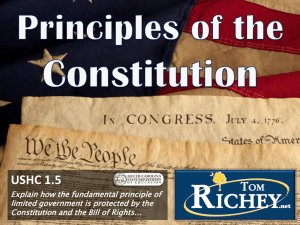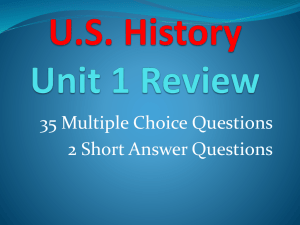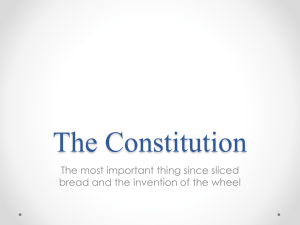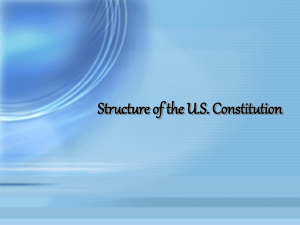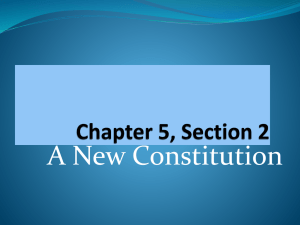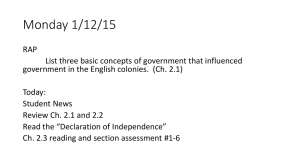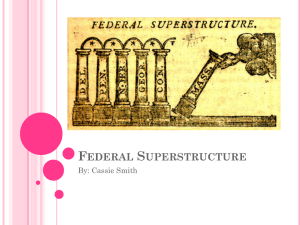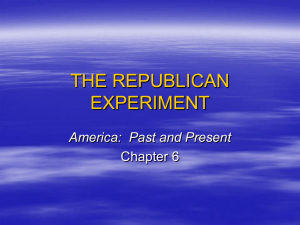Unit 1 Powerpoint Notes
advertisement
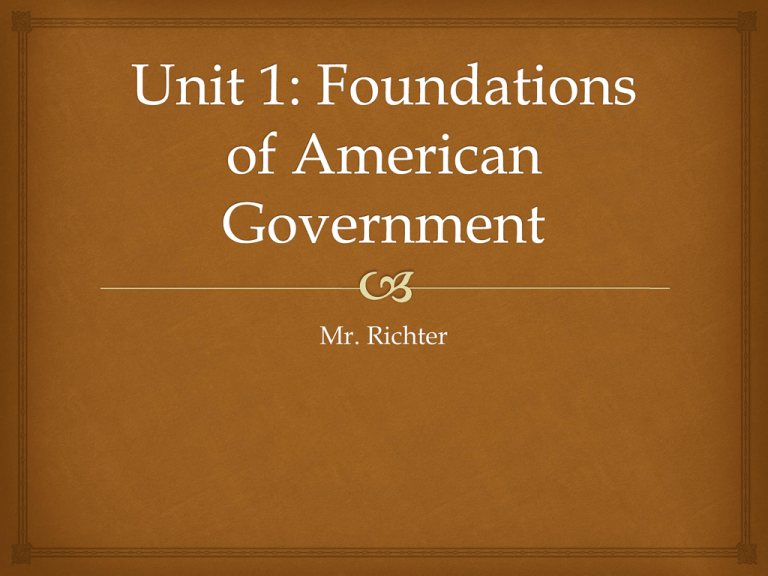
Mr. Richter Government and the State Objectives Understand how public policy affects our lives Identify the three main forms of governmental power Explain the difference between democracy and a dictatorship What is government? Government is the institution through which a society makes and enforces its public polices A public policy is what the government decides to do Examples? Three types of governmental power Legislative power Power to make laws and frame public policies Executive power Power to execute, enforce and administer the law Judicial power Power to interpret the law and settle disputes The Constitution Document that outlines the powers of the government is often called a constitution Different types of constitutions? Types of Government Dictatorship Ultimate responsibility of the government rests on one person or a small group of people Those who rule cannot be held responsible to the will of the people Types of Government Democracy Supreme authority rests with the people Politics ≠ Government Politics The process of distributing power and resources Government The institution where those decisions are made The State A body of people, living in a defined territory, organized politically, and with the power to make and enforce law without the consent of any higher authority Must have… Population Territory Sovereignty Government Origins of the State Force Theory One person or a small group forced the rest of the population to submit to their rule Evolutionary Theory A family was the center of government and over time the related families became “clans” Origins of the State cont. Divine Right Theory God created the state and gave those who were ruling a “Divine Right” to rule Social Contract Theory Humans first lived in a “State of Nature” where people could take whatever they wanted by force Humans eventually countered this by agreeing with each other to establish rules of conduct or a “government” The Purpose of Government Form a more perfect union Establish Justice Insure domestic tranquility Provide for the common defense Promote the general welfare Secure the blessings of liberty Objectives Understand how public policy affects our lives Identify the three main forms of governmental power Explain the difference between democracy and a dictatorship Forms of Government Objectives Identify ways that power can be distributed Understand the characteristics of the different types of governments Explain the systems of government and who can participate Three Classifications of Government Who can participate in the governing process Geographic distribution of governmental power within the state Relationship between the legislative and executive branches of government Who can participate Democracy Supreme authority rests with the people Direct Democracy Will of the people is directly translated into public policy Town hall meetings Indirect Democracy Representative Democracy People elect representatives to create public policy Who can participate cont. Dictatorship Those who rule cannot be held accountable to the will of the people Autocracy Single person holds power Oligarchy Power to rule is held by a small group of people. Usually self-appointed Geographic Distribution of Power Unitary Government All powers held by the government belong to a single central agency Federal Government Power of the government is divided between the central government and several local governments Division of Powers Is stated by a higher authority that is above the central and local governments Ex. US Constitution Geographic Distribution of Power cont. Confederate Government Alliance of independent states(countries) Their power is very limited and is decided by the states Presidential Government Executive and Legislative branches of government are separate from one another and are elected separately The United States invented this form of government structure Parliamentary Government The Prime Minister or Premier are actual members of the legislative branch or Parliament Prime Minister is selected as the leader of the majority party in Parliament There are no set terms for the Prime Minister and may be removed by a “vote of no confidence” Objectives Identify ways that power can be distributed Understand the characteristics of the different types of governments Explain the systems of government and who can participate Assignment What form of government do you think works best? In essay form, half page hand written. Basic Concepts of Democracy Objectives Understand the foundations of democracy Explain the free market system Identify the importance of compromise Foundations of Democracy Worth of the Individual Each person in a democracy has worth Democracies serve the interests of the many Equality of all persons Equality of opportunity Equality of the law Majority Rule, Minority Rights The majority of people will be right more often than wrong Necessity of Compromise Must find a position acceptable to the largest number Individual Freedom Does not insist on COMPLETE freedom of an individual “The right to swing my fist ends where the other man’s nose begins” Justice Oliver Wendell Holmes “The rights of every man are diminished when the rights of one man are threatened.” John Fitzgerald Kennedy Free Enterprise System Started from specialization A person or group makes similar items to sell rather than many items to use Four factors of Free Enterprise Private ownership Individual initiative Profit Competition Free Enterprise cont. Law of supply and demand Drives the economy Mixed economy Free market mixed with governmental involvement in regulation How does the government regulate our economy? Homework Section 1.3 Assessment numbers 1-6 Objectives Understand the foundations of democracy Explain the free market system Identify the importance of compromise Our Political Beginnings Objectives Identify the three basic concepts that influenced government in the English Colonies Understand the significance of the Magna Carta Describe the three types of colonies that the English established in North America Ordered Government Early English settlers established local governments that could help people on a more individual basis Counties Townships Sheriff Grand Jury Limited Government Government is not allpowerful and cannot take away certain rights from the individual This idea had been a part of English life since the 1200s so naturally it was brought over to the Americas The Magna Carta Meaning “Great Charter” forced the nobility of England to submit to the laws of the people This document signed by the Barons or landowners of England protected the people against absolute power of the king Representative Government Government that serves the will of the people Idea that people should have a voice of what the government should do and not do Other Noteworthy Documents The Petition of Right and the English Bill of Rights were important documents that further limited the powers of the monarchy Petition of Right British Parliament began to grow in influence after the Magna Carta In 1628 when King Charles I asked for more taxes, Parliament refused and signed the Petition of Right This document prevented the king from… Unlawful imprisonment Imposing martial law in times of peace Requiring homeowners to house soldiers against their will English Bill of Rights 1688 British Parliament offered the crown to William and Mary of Orange William and Mary were required to sign the new English Bill of Rights This document Prohibited a standing army in peacetime Outlined the rights to a fair trial Removed cruel and unusual punishment English Colonies in America Royal Colonies Subject to direct control of the Crown Proprietary Colonies The King grants an area of land to a person who has complete rule over the area Charter Colonies The King grants a charter, or a written grant of authority, to a group of people These were made for religious purposes Types of Legislature Unicameral Legislature is only one house Bicameral Legislature has two houses Objectives Identify the three basic concepts that influenced government in the English Colonies Understand the significance of the Magna Carta Describe the three types of colonies that the English established in North America The Coming of Independence Objectives Explain some of Britain’s colonial policies Compare the outcomes of the First and Second Continental Congress Identify the ideas of the Declaration of Independence British Policies for Colonies The King had a majority of control of the colonies Parliament did not get involved at first The colonies were largely self-reliant because of the large distance between them and England By the mid-1700s the colonies relationship with England was mostly Federal in form King George III Takes crown in 1760 Began taxing colonists to pay for British troops being stationed in America Colonists objected Claimed they should not be taxed without representation in parliament “No Taxation without Representation” Early Attempts at Independence Albany Plan of Union Idea made by Benjamin Franklin to form an annual congress of delegates from each colony to meet The plan was turned down by the colonies as well as the Crown Stamp Act Congress Stamp Act passed in 1765 required the use of “stamped” legal documents, business agreements and on newspapers Colonists began boycotting certain English Goods The First Continental Congress 1774 Parliament passed the Intolerable Acts to punish the colonists for their defiance Delegates from every colony except Georgia met to discuss the repeal of the Intolerable Acts They sent a Declaration of Rights to Parliament protesting colonial policies Second Continental Congress The British government did not repeal the Intolerable acts and reacted to the Declaration of Rights with even more repression SCC met in Philadelphia in May 1775 Each of the 13 colonies sent a representative A continental army was created and George Washington was appointed commander The SCC became our first national government The Declaration of Independence A year after the Revolution began, a proposition was made to the SCC to declare complete independence from Britain Congress named a committee of 5 to create the Declaration but it was dominated by one Thomas Jefferson July 4th,1776 the Declaration of Independence was signed and the United States of America became a nation State Constitutions Each state was urged to write a constitution to “best conduce to the happiness and safety of their constituents” Outlined the ideas of four main points Popular Sovereignty Limited Government Civil Rights and Liberties Separation of Powers Popular Sovereignty The government can only exist and function only with the consent of the governed The people hold power and the people are sovereign Limited Government The powers given to the government were given reluctantly and contained many regulations People in power could not be in power for long terms. Typically no more than 1 or 2 years Most power rested in the Legislature Civil Rights and Liberties Sovereign people had certain rights that the government must respect at all times Many of the new state constitutions contained a “Bill of Rights” Establishing untouchable rights for the people Separation of Powers A “Checks and Balances” system was put in place The governments were divided into three branches Executive, legislative and judicial Each branch had the power to restrain the actions of other branches Objectives Explain some of Britain’s colonial policies Compare the outcomes of the First and Second Continental Congress Identify the ideas of the Declaration of Independence The Critical Period Objectives Explain the structure of government set up under the Articles of Confederation Identify some of the weaknesses of the Articles Describe the events to plan a new constitution The Articles of Confederation Explain the Articles of Confederation Each state was an individual only to come together for common defense and security of their liberties. What is ratification Formal approval Characteristics of Articles of Confederation Government Structure Unicameral congress, each state had one vote Powers of Congress Make war and peace, borrow money, settle disputes State Obligations Pledged to obey the Articles, provide funds and troops Weaknesses No power to tax, regulate trade between states The Critical Period What were the states doing that caused problems? Making allies with foreign nations, taxing other states, printed their own money What was Shay's rebellion? Landowner attacked a federal arsenal because he was upset about taxes and debts Need for Stronger Government Representatives from what two states met at Mt. Vernon to propose a change to the Articles Virginia and Maryland Why was the Annapolis meeting unsuccessful? Only 5 of the 13 representatives from the states attended Where was the proposed meeting place of the next convention? Philadelphia What was that meeting later called? Constitutional Convention Creating a Constitution Objectives Identify some of the main participants of the Constitutional Convention Compare and contrast the New Jersey plan and the Virginia Plan Understand the idea behind the three-fifths compromise Framers of the Constitution 12 of the 13 states sent delegates to Philadelphia All but Rhode Island Included 55 men that were chosen as delegates from their respective state Birth of a Constitution George Washington was named president of the convention Delegates were required to work in secret, so they couldn’t be influenced by outside sources James Madison was the convention’s floor leader and had a hand in most of the document The Virginia Plan Called for a new government consisting of… Three branches – Executive, Legislative and Judicial Bicameral Legislature – House and Senate Members are represented by population and monetary donations The New Jersey Plan Wanted to amend the Articles Retained the “Congress of the Confederation” Unicameral Legislature Had the power to tax and regulate trade between the States Members of congress would be represented equally for each state Need to Compromise Large states expected to dominate Small states were worried that they wouldn’t have any voice Connecticut Compromise Senate – members represented each state equally, 2 members from each state House of Representatives – representatives based on population More Compromises Three-fifths compromise Question of slaves being a part of the population for southern states Slaves were to be counted as three-fifths of a person Commerce and Slave Trade compromise Congress could not tax exported goods and could not act on slave trade for at least 20 years Objectives Identify some of the main participants of the Constitutional Convention Compare and contrast the New Jersey plan and the Virginia Plan Understand the idea behind the three-fifths compromise The Six Basic Principles Objectives Identify the six basic principles of our constitution Understand why each of the principles are important Explain the importance of the court case Marbury vs. Madison The Law of the Land Written in 1787, ratified in 1789 The purpose of the constitution is in its Preamble We the people… Divided in seven numbered sections called Articles Articles are followed by 27 amendments Changes made to the document over the past 200 years Basic Principles Popular Sovereignty People are the only source for any and all governmental power Limited Government Government is not all-powerful, can only do things that the people have given them power to do Rule of law – government and its officers are never above the law Basic Principles Separation of Powers Power is divided between the Legislative, Executive and Judicial Branches Checks and Balances Each branch of government can be restrained by the other two Ex. Presidential Veto Rejecting an act of congress Basic Principles Judicial Review Courts decide whether governmental actions are aligned with the constitution Power to declare an act Unconstitutional Marbury vs. Madison Court case that established the courts ability to deem something unconstitutional Federalism Division of power between the central government and several regional governments (states) Objectives Identify the six basic principles of our constitution Understand why each of the principles are important Explain the importance of the court case Marbury vs. Madison Reading Quiz 1. What is an anti-federalist 2. On what two states did the success or failure of ratification depend? 3. Where was the first US Capitol located? Formal Amendment Objectives Identify the four different ways to formally amend the Constitution Explain the limits of the formal amendment process Understand the history of the 27 amendments to the Constitution Has the Constitution changed? Been a document that has lasted over 200 years Can be changed in two ways, Formally and Informally Formal Amendment Changing the Constitution itself There has been 27 formal amendments Four different methods of formally amending the Constitution Formal Amendment Cont. Formal Amendment Cont. There has been 10,000 resolutions sent to Congress to amend the Constitution 33 has been sent to the States for ratification 27 have passed Bill of Rights First ten amendments to the Constitution Set up basic freedoms and liberties for the American public Were added within three years of the ratification of the Constitution 27 Amendments Objectives Identify the four different ways to formally amend the Constitution Explain the limits of the formal amendment process Understand the history of the 27 amendments to the Constitution Informal Amendment Objectives Identify how basic legislation has changed the Constitution over time Explain how the executive and judicial branches can amend the constitution Understand the role of party practices and custom in shaping the Federal government Informal Amendment Changes made to the Constitution that has not involved changes to its written words How the? Basic Legislation Executive Action Court Decisions Party Practices Custom Basic Legislation The constitution is the framework of our laws and practices Congress builds on what the constitution says Executive Action Actions of the president that are not granted specifically in the Constitution Declaring War Executive Agreement Pact made by the President directly with a head of foreign state Treaty Formal agreement that must be passed through Congress Court Decisions The court system are continually making decisions that informally change the constitution Woodrow Wilson said about the Supreme Court, “a constitutional convention in continuous session.” Party Practices George Washington warned against political parties But they have been in existence since the early 1800s Nominating candidates Electoral College Has heavy influences by political parties Custom Over the course of 200 years, many different customs or traditions has shaped our government Cabinet Heads of 14 different divisions make up the presidential cabinet “No third term” Presidential custom, broken by FDR Objectives Identify how basic legislation has changed the Constitution over time Explain how the executive and judicial branches can amend the constitution Understand the role of party practices and custom in shaping the Federal government Federalism: The Division of Power Objectives Explain federalism and why the Framers of the constitution chose this system of government Identify the different powers of the National and State governments Understand that the National Government holds exclusive powers but also hold concurrent powers within the states Why Federalism? Governmental power poses a threat to individual liberty Exercise of governmental power must be restrained Dividing governmental power prevents its abuse Federalism by Definition Federalism divides power between a central government and regional governments Known as Division of Powers Federalism allows for local action for local concerns National action on national concerns Powers of National Government The national government has delegated powers Powers given to them from the constitution There are three distinct types of delegated powers Expressed Implied Inherent Expressed Powers Constitution spells out the powers given to the National Government Sometimes called “Enumerated Powers” Powers include Collect taxes Declare war Fix standards of weights and measures Implied Powers Implied - Powers not expressly stated in the Constitution They are “Implied” Congress is given “Necessary and Proper power to make laws” Inherent Powers Powers possessed by a National Government because it is a sovereign state in the world community Examples Regulating immigration Deport aliens Acquire territory Powers Denied to the National Government In the Constitution it says that the National Government cannot take freedoms granted in the Bill of Rights Powers not written in the Constitution The States 10th amendment gives states “Reserved” powers Powers not granted to the National Government States have the power to create laws or regulations that are not already made in the National Government States are denied powers that the National Government already possess Making treaties, coining money etc Concurrent and Supremacy Clause Concurrent powers Powers shared between the State and National Government Crime & punishment, taxes, etc. Supremacy Clause US Constitution over all, acts of Congress next US Supreme Court power over states Objectives Explain federalism and why the Framers of the constitution chose this system of government Identify the different powers of the National and State governments Understand that the National Government holds exclusive powers but also hold concurrent powers within the states National Government and the 50 States Objectives Identify the obligations the Constitution places on the nation for the benefit of the states Explain the process for admitting new states Understand the many areas of cooperative federalism The Nations Obligations What does “republican form of government mean?” Representative government If a state is invaded by a foreign force, does the national government have to do anything? Yes, under the constitution the National government must protect the states What does it mean to respect the territorial integrity of each state The national government must recognize and respect the legal existence and physical boundaries of each state Admitting New States Who has the power to admit new states to the union Congress What dose the “enabling act” do? Directs the people of the proposed state to draft a state constitution What is an “act of admission” An act creating a new state Cooperative Federalism Why are “grants-in-aid programs” important? They help provide funding so state and local governments can operate What is “revenue sharing” Congress gave tax revenue to states and their local governments to use how they wanted What are the three types of “grants-in-aid” that congress gives to? Categorical grants, block grants, and project grants Objectives Identify the obligations the Constitution places on the nation for the benefit of the states Explain the process for admitting new states Understand the many areas of cooperative federalism Interstate Relations Objectives Explain why states make interstate compacts Identify what extradition is and what is its purpose Interstate Compacts Agreement between states and or foreign states Must be allowed by congress Examples Conserving resources Promote vehicle safety Extradition A fugitive from justice who leaves the state of his crimes, must be returned to his/her original state You cannot escape justice by leaving the state Privileges and Immunities No state can draw unreasonable distinctions between it sown residents and those in other states Examples Allow buying property in other states Get married in other states Hunt/fish Go to college Objectives Explain why states make interstate compacts Identify what extradition is and what is its purpose
